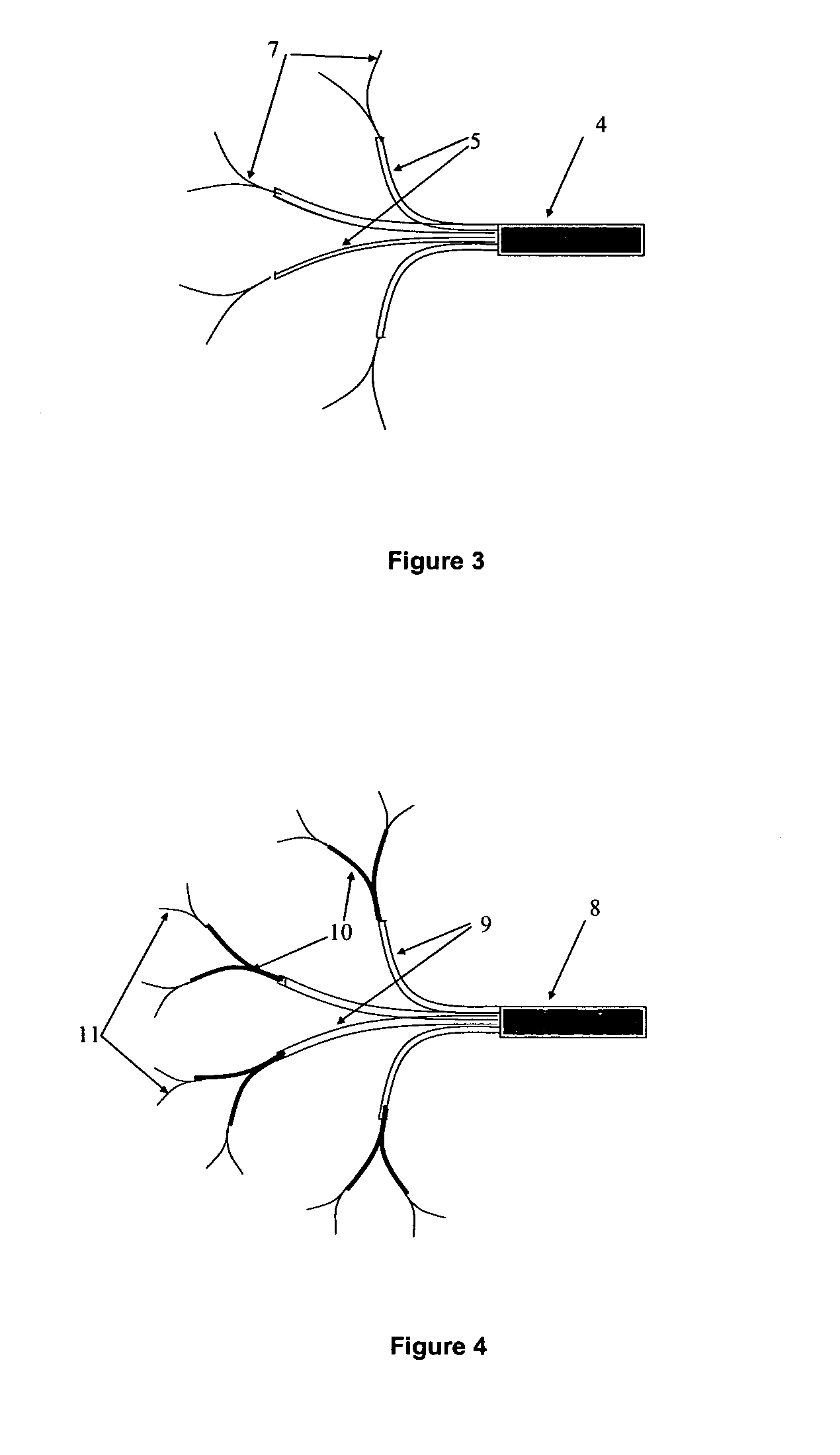However, this is not the case for many solid tumors that have advanced to later stages.
Due to the invasion of the surrounding tissues by tumor processes, any surgical procedure that would serve to remove all the cancerous cells would also be likely to maim or destroy the organ in which the
cancer originated.
Similarly,
radiation treatments intended to eradicate the cancerous cells left behind following
surgery frequently lead to severe and irreparable damage to the tissues in and around the intended
treatment field.
Neither surgeons nor radiotherapists have the tools to eliminate individual
tumor cells, microscopic tumor processes, or tumor-associated vasculature from the otherwise
normal tissue surrounding
locally advanced solid tumors.
Despite the above mentioned benefits, and its widespread use, conventional
radiation therapy cannot cure
locally advanced solid tumors, because, in order to
gain access to a tumor
mass, x-
ray beams usually must pass completely through the body; therefore,
exposure to normal tissues is inevitable.
In addition, x-
ray beams lack the microscopic accuracy needed to eliminate individual
cancer cells from the
treatment field.
X-rays cannot eradicate or cure most types of locally advanced solid tumors, because they lack the specificity needed to kill cancer cells while sparing the normal cells in the treatment field.
Unfortunately, this approach is of limited value even in instances when the x-
ray beam can be focused precisely on the treatment field.
The main problem is that x-rays cannot discriminate between the cancer cells and normal cells within the treatment field.
Regardless of how precisely one defines the treatment field, and regardless of how precisely the x-ray beam is projected through the treatment field, x-rays will damage normal cells in the treatment field, and radiotherapy beams do not have the microscopic accuracy needed to eliminate individual cancer cells from the treatment field.
Thus, even the most precise digital pre-treatment planning cannot overcome the inherent deficiencies of
ionizing radiation.
Most types of
chemotherapy also suffer from a lack of tumor specificity and also cause collateral damage to normal tissues, since chemotherapeutic agents are distributed throughout the body and exert their effects on normal cells as well as
malignant cells.
The deficiencies of current treatment modalities are especially glaring with respect to specific types of cancer, for example
glioblastoma multiforme (GBM), a highly aggressive type of cancer that constitutes the most common form of brain
malignancy.
Indeed, after nearly 35 years of investigations involving hundreds of experimental treatments and thousands of GBM patients participating in clinical trials, the prognosis of patients with
newly diagnosed GBM is dismal.
However, the challenge is great, because the majority of chemical entities do not diffuse far into
brain tissue or other types of solid tissues.
Currently available methods of
convection enhanced delivery have several limitations and drawbacks.
One of the biggest problems is to determine the optimal position of the catheter tips.
Another problem that aggravates the optimal positioning of catheter tips is tissue swelling.
This makes it quite difficult to accurately position the tips of catheters into the perimeter of the
surgical resection cavity.
Insertion of such thick catheters from inside of the
surgical resection cavity is challenging because of the minimum depth requirement, by their limited
pliability, and by their sheer bulk.
The use of 2.5 mm OD catheters may increase the risk of hemorrhage and / or trauma to nervous tissues as compared with thinner catheters.
Given the above constraints it is very difficult to consistently arrange the tips of thick catheters into an orderly distribution around many surgical resection cavities.
Another
limiting factor is that each catheter supplies a large proportion of the intended treatment field, e.g. 33% of the treatment field for 3 catheters, and 50% of the treatment field for 2 catheters.
A high proportional flow per catheter is an unavoidable consequence of using only a few catheters, and has the effect of reducing the accuracy of
convection enhanced delivery.
In addition, the use of a high fractional flow per catheter, and the fact that the catheters must be inserted from the surface of the brain, limits the surgeon's available options for
catheter insertion.
Based upon clinical experience from many
convection enhanced delivery studies involving patients with brain tumors, 2-3 catheters appear to be insufficient to provide optimal
biodistribution of drugs around many surgical resection cavities.
In this regard, a major issue revealed by studies of
gene expression profiling, is that tumors are genetically and metabolically much more heterogeneous than previously anticipated.
Despite the recognition that 125IUDR has a unique
cell killing capability, and despite many years of research aimed at exploiting this
mechanism of action, including the concept of directly introducing 125IUDR into tumors (for example, see Kassis et. al., “Treatment of tumors with 5-radioiodo-2′-
deoxyuridine,” U.S. Pat. No. 5,077,034), these agents have not been successfully applied to the treatment of cancer.
The delivery of 125IUDR and related agents to solid tumors, using systemic or local administration, has proven to be extremely challenging.
 Login to View More
Login to View More 


